Original article published on 16 September 2020
In this article we want to surprise you with a selection of unique toponymic plaques of Lisbon.
They’re different from the traditional and official models that we shared with you in Typologies of Toponymic Plaques of Lisbon, where we talked about their connection with the development and occupation of urban space.
This time we suggest you see completely different plaques that break the mould. They’re discreet details that reveal particularities and tell us interesting episodes related to this fascinating city.
Get to know Lisbon’s historic neighbourhoods in a guided tour and discover unmissable places of this magnificent city.
The Selection of Unique Toponymic Plaques of Lisbon
There are many non-official toponymic plaques of different formats and materials that we observe during our walks.
The ones we present you give us information about the municipality itself, its connection to the world and about some of the different personalities that marked Lisbon in distinct ways.
Luís de Camões Square
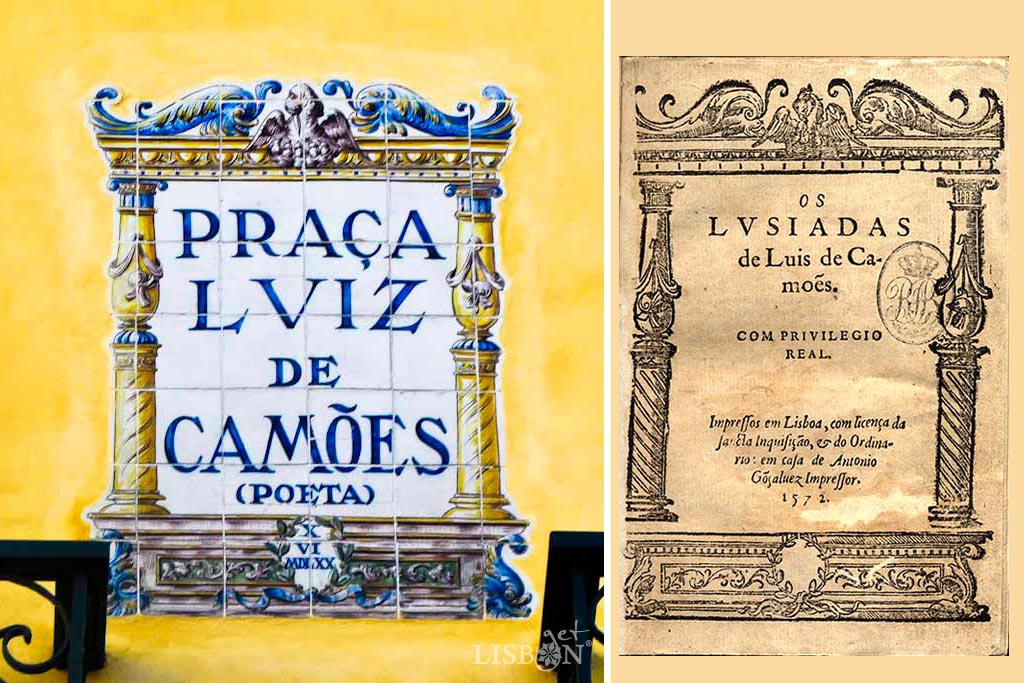
We start with Luís de Camões Square, toponym attributed by the Notice of the Civil Government of Lisbon of October 12, 1860. In the corner with Rua do Alecrim we can observe on the building a curious toponymic plaque, an irregular-shaped tile panel.
This panel reproduces a colour version of the illustration from the first edition of Os Lusíadas, edited in 1572. This is a renaissance drawing composed of architectural elements with plant-inspired decoration that surround the text.
We can read PRAÇA LUIZ DE CAMÕES (POETA), translated to Luís de Camões Square (poet) and a date for which we can’t find an explanation. In roman numerals, X-VI-MDLXX means June 10, 1570. But the death date of the poet was June 10, 1580. Could they’ve forgotten an X?
In this square we can also find a monument built in honor of the poet Luís de Camões, which was inaugurated on October 9, 1867. It was produced by the sculptor Vítor Bastos (1830-1894), who among other pieces, was the author of the statues from the top level of the Triumphal Arch of Praça do Comércio.

As we celebrate the 500th anniversary of the birth of Luís Vaz de Camões, it is important to understand and reflect upon the work of this significant writer and poet, as well as revisit landmarks related to him in the city of Lisbon.
At each stop along this journey, a poem or gloss by him will be read. Through his work and the places he frequented, we will witness Camões’ loves and heartbreaks, the poet’s life in the 15th-century court, the countless disputes and struggles until his departure for the East, where he wrote much of his major work: “The Lusiads.”
Feel free to email us at [email protected] to book your private or individual English-spoken walking tour led by the historian and guide Marisa Filipe, and embark on an unforgettable adventure with getLISBON.
Município Square

This toponymic plaque that seems to be from the same timeframe as the plaque from Luís de Camões Square, is a beautiful example of Portuguese tilework. It was placed on a façade right in front of the City Council of Lisbon.
Previously named Pelourinho Square, this place was renamed Município Square by the Council Notice of March 24, 1886.
This plaque is constituted by painted and irregular-shaped tiles. On its top there’s a caravel with Lisbon’s flag and on the bottom the representation of the badge and the Colar of Military Order of the Tower, and of the Sword, of Valour, Loyalty and Merit.
This peculiar element is an evocation to the pinnacle of the Portuguese honours system, distinction that the City Council of Lisbon earned on January 30, 1920.


The Toponymic Plaques of the Military Museum of Lisbon

On the west corner of the building of the Military Museum of Lisbon, in the zone of Alfama, we can see two unique toponymic plaques of Lisbon. One corresponds to Museu D’Artilharia Square and the other to Rua Teixeira Lopes (the cover photo of this article).
The former is a bronze oval-shaped plaque with relief letters that reveals to us the former name of the museum, which has had its current name since 1926.
The latter is more elaborate. It is shield-shaped, has two dragons on the side and is crowned with plant-inspired motifs. In this plaque the text is engraved.
The street was named Teixeira Lopes in 1903 and refers to the illustrious family of artists: José Joaquim Teixeira Lopes (1837-1918), sculptor and ceramist; and his sons, the sculptor António Teixeira Lopes (1866-1942) and the architect José Teixeira Lopes (1872-1919).
It must be highlighted that António Teixeira Lopes is the author of the sculptural set of the east portal of the Military Museum of Lisbon, where the allegorical figure of the nation (c.1908) is represented. And his brother was responsible for the architectural project of remodeling the building, which occurred between 1905 and 1908.
We don’t know when these plaques were attached but we know for sure they didn’t exist in 1905, according to pictures in the Municipal Archive of Lisbon. The material used was certainly a reference to the old foundry of the Army Arsenal that operated there.
Estrela d’Ouro Neighbourhood
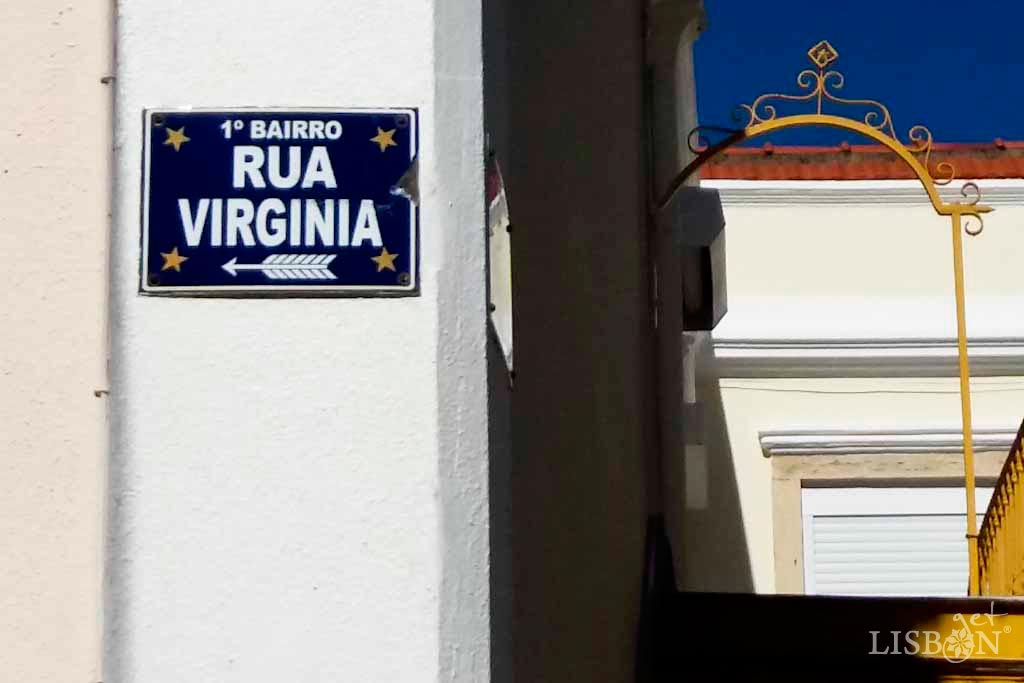
The Estrela d’Ouro Neighbourhood in Graça is a vila operária (neighbourhood attributed to workers) that was projected by the architect Norte Júnior in 1907.
This project was born from the initiative of Agapito Serra Fernandes, a Galician businessman from the confectionery world, and was destined to accommodate his workers.
The vila is composed of four streets and all of them are named after his family members: Rua Virgínia, Rua Josefa Maria, Rua Rosalina and Rua Serra Vidal. These toponymic plaques have specific and identifying characteristics of this neighborhood.
They’re rectangular metal plaques, painted blue with white letters and each corner has a yellow five-pointed star.
This element is present in the entire neighbourhood: in its name, in the Portuguese pavement, in the wrought iron decoration, in the tile panels and in other decorative pieces.
The reason behind it was a tribute that the businessman wanted to make to the Campus Stellae (field of the star), one of the potential etymological origins of Santiago de Compostela.
Rafael Bordalo Pinheiro Square

This square in Chiado, in the heart of Lisbon, was named after Rafael Bordalo Pinheiro (1846-1905), one of the greatest Portuguese artists in 1915.
The ceramic toponymic plaques there remind us of his work as a creative ceramist that lived and passed away in the building no. 29 of this former Abegoaria Square.
You can see some of his important art pieces in the fun Bordalo Pinheiro Museum, as well as fantastic ceramic animals in the Bordalo Pinheiro Garden, both located in Campo Grande.
Rio de Janeiro Avenue
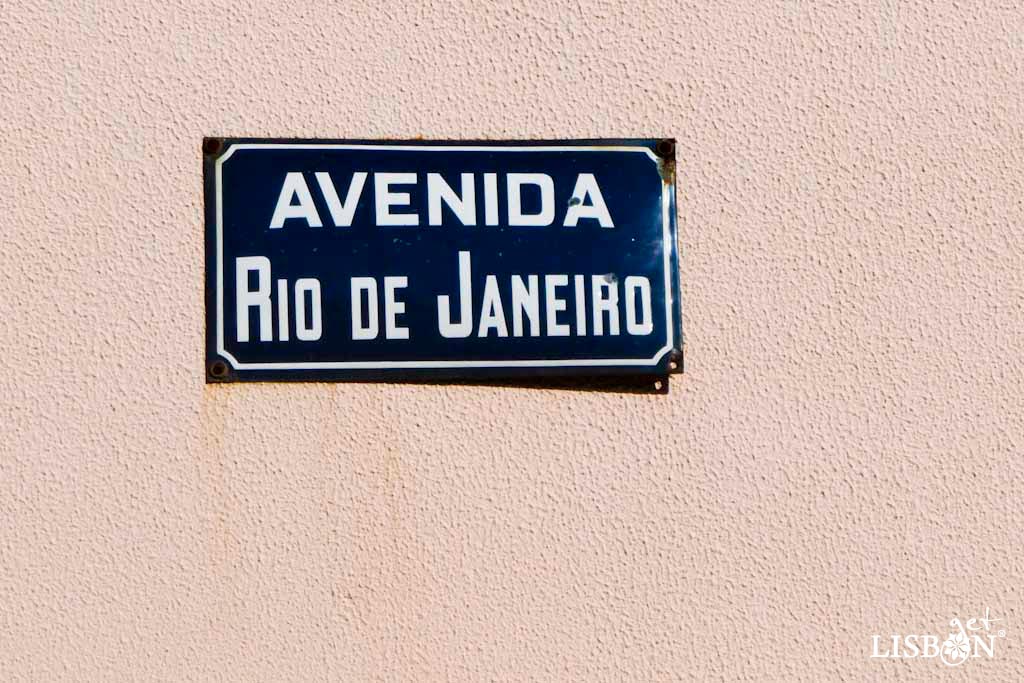
This artery that connects Estados Unidos da América Avenue to Brasil Avenue got its current name in 1948.
It is part of a group of streets to whom were attributed names of European and Brazillian cities, giving a certain cosmopolitan feel to Lisbon at the time.
The metal dark-blue with white letters plaques that can be seen along this avenue are a tribute to the city of Rio de Janeiro where the model used for toponymic plaques is the same.
Madrid Avenue
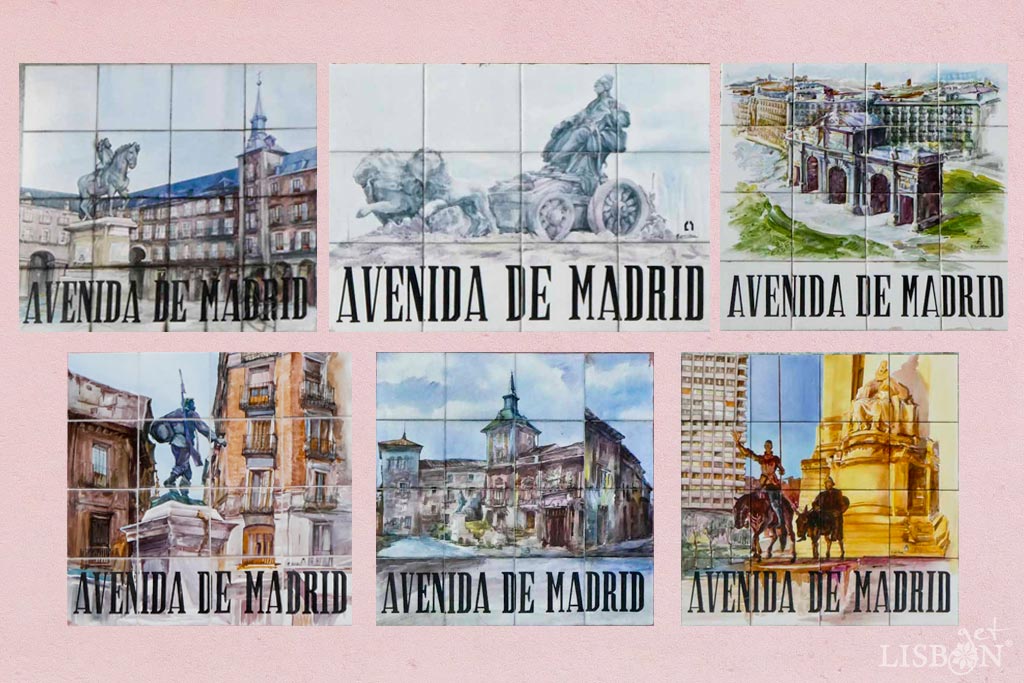
Throughout this entire avenue we can find six tiled toponymic plaques with different paintings allusive to Madrid and signed by R. Del Olmo.
Among emblematic monuments and places we have: in the beginning of the avenue on the left side the Equestrian Statue of Filipe III in Plaza Mayor; on the right side the Cibeles Fountain and further ahead the Puerta de Alcalá; on the building no. 28 the Statue of Eloy Gonzalo in Plaza de Cascorro; and in the end of the artery we can see on the left side a different view of the Plaza Mayor and on the opposite side, the last of the six plaques, the Monument of Don Quixote in Plaza de España.
These plaques are similar to the ones used in the Spanish capital and were placed in 1986 for the Madrid week in Lisbon.
| Never miss another article | Subscribe here |
Rua de Macau
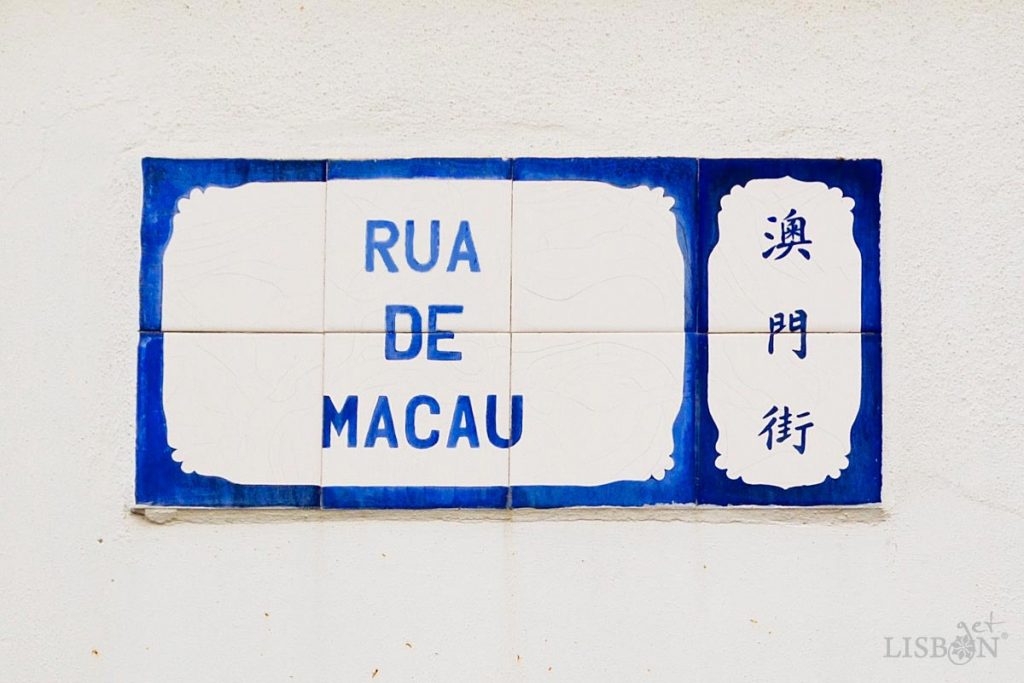
The last of the unique toponymic plaques of Lisbon that we’ve selected for you is in Rua de Macau in the old Bairro das Colónias (Colonies Neighbourhood), one of the 7 Marks of Macau in Lisbon shared by us.
This neighbourhood was built in the 1930s and its streets were named after Portuguese territories then.
In 1999, when the sovereignty of Macau was passed on from Portugal to China, two toponymic plaques were placed. Their model is the same as the one used in Macau since the 80s.
This model is made of a white tile panel with a blue frame and is divided in two sections: one for the Portuguese street name and the other for the Chinese name.
You can confirm this info in the cover picture of the article 7 Marks of Lisbon in Macau. 😉
This is our selection of unique toponymic plaques in Lisbon. With them we hope we’ve helped promote a more curious and attentive look at these and other singularities in this wonderful city.
The project getLISBON has been very rewarding and we want to continue revealing the singularities of fascinating Lisbon.
Help us keep this project alive!
By using these links to make your reservations you’ll be supporting us. With no extra costs!
• Looking for a different experience? We can create a customised itinerary based on your interests. Contact us!
• Or if you prefer tours and other activities in various destinations, take a look at GetYourGuide.
• Save time and money with a flexible Lisbon Card!




